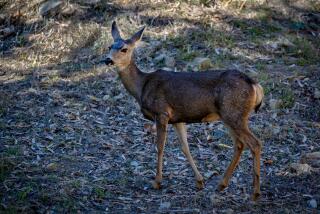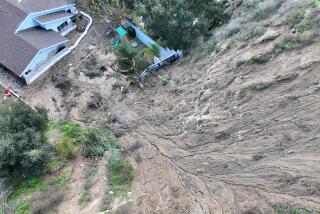When Pigs Go Hog Wild : Animals: In a Riverside County river bottom, a growing population of swine pose a hazard both to people and the environment.
- Share via
PEDLEY, Calif. — The thicket-like Santa Ana River bottom has for years been a notorious hiding place for fugitives, stolen cars and marijuana plants.
Those problems Riverside County authorities have been able to control.
They are not so sure, however, when it comes to an ever-growing population of domestic pigs, now running wild along a 7-mile stretch from Riverside west to the Prado Basin. Increasingly, horseback riders have spotted the elusive, 300- to 400-pound hogs bursting through bamboo-like grass and onto the county’s popular Santa Ana River Regional Park trail system.
“They just crush right through the trail,” said Mark Hernandez, who has spotted the pigs at least seven times in as many months when he took evening rides on the trails near Pedley, west of Riverside. “There’s no warning. And they’re huge.”
Authorities fear that the population of the hogs, estimated from 300 to 400, could spiral out of control. Although they pose no apparent danger, parks officials and horse owners say that the pigs could scare horses, throwing inexperienced riders to the ground. No one has been hurt so far.
“It’s going to be a danger pretty soon,” said Hernandez, who sits on a special committee that is trying to come up with a way to get the hogs back to their livestock roots. “I know it’s going to be a kid or an Orange County rider out here on the weekend that gets thrown from a horse.”
County officials say the pigs were first seen in the region in 1985. But theories about how they got there vary; some say that they escaped from nearby hog auctions or farm pens, living off the land and multiplying ever since.
Other, more conspiratorial theories point at a disgruntled Rubidoux ranch owner who, they suspect, released about two dozen pigs to the wild as a way of getting back at the county over a land dispute.
Whatever the case, once they were free, the swine had no problem making the river their home. Pig experts say that they are attracted to the swampy area, where they can live on fruits, nuts and wild berries, and a host of other foods. At the same time, they can hide in the dense grass which grows to 12 to 15 feet high and shields parts of the river from above.
“They’ll migrate right to the riverbed; that’s their survival,” said Sandy Tourigny, who runs Zar’s Red Power Durocs, a pig farm in Mira Loma. “They start reverting back to the wild.”
Pig experts say that by all accounts, the animals are not prone to attack. Some hogs may be growing inch-long tusks, but nothing close to the long tusks found on wild boars.
“If you go in there and start beating on them, like any animal, they are going to respond,” Tourigny said. “Usually the pig is lying there. They’re not going to go ‘rrrrhr’ to scare you.”
Still, county officials warn that the pigs want to be left alone. Even though they have changed in the wild, they are still stubborn. As Hernandez was riding at dusk on Tuesday night, he sighted a herd of two dozen pigs crossing the trails. This time, one stopped and looked at him, he said.
“If you make any attempt toward them they will challenge you,” Hernandez said. “I just tightened my reins, and one of the pigs grunted and took a few steps toward me.”
But the problem goes beyond scaring the daylights out of equestrians. The pigs are apparently destroying the riverbed’s natural habitat, home to the least Bell’s vireo, a bird on the endangered species list. County officials call it yet another side effect of urban sprawl.
“You dump these pigs, and look what it’s caused,” said Paul Frandsen, deputy director of operations and natural resources for the county parks agency. “We know we’re going to have to do something about it. It’s not an easy issue.”
Since the summer, the county parks agency has been working with the state Fish and Game Department and the U.S. Fish and Wildlife Service to study ways of curbing the population growth.
“Pigs are extremely destructive to the vegetation,” said Carla Wakeman, a natural resource specialist for Riverside County. “Their rooting is destructive. They root for insects, earthworms, larvae. But it’s not so much what they eat as what they destroy.”
Population control will not be easy. Experts believe females can produce about five or six piglets to a litter, and can give birth as often as twice a year.
“It’s like boom, boom, boom and you got pigs coming under your desk,” Frandsen said. Even if a controlled hunt was allowed, hunters probably would not track down enough pigs to make a dent in the population. Conversely, “If you do nothing they will continue to grow.”
Gun and archery clubs have offered to kill them, either from the ground or by helicopter. And some horse riders say that they already have seen hunters hauling off dead hogs, presumably for a barbecue.
But public officials say that a controlled hunt could become a political mud bath, and it might not make much of a dent in the pig population anyway.
“How do you go find one?” Frandsen said. “It would be hell to get them out.”
Another proposal calls for placing pens along the river bottom and feeding the pigs. Gradually, they would grow accustomed to the offer of a free and easy meal, and would come in greater numbers. Then, one night, the pens would be locked, trapping a large share of the herds. The pigs then would be auctioned or sold to farmers, depending on whether they are healthy enough.
“This would be a humane approach, and it would be time-consuming,” said Rosanna Scott, senior administrative assistant to Riverside County Supervisor Melba Dunlap, who represents much of the unincorporated area. “But if we sold the pigs, we probably could recoup the cost. They are very large, and they are probably very tasty.”
If that does not work, chances are Dunlap will not be the only elected official saddled with the pig problem. During next year’s redistricting, the river will be split in three, and two other supervisors will have to deal with it. It remains to be seen whether the pigs will be an election issue.
“We have all kinds of challenges to government right now,” Scott said. “We didn’t need this one.”
More to Read
Sign up for Essential California
The most important California stories and recommendations in your inbox every morning.
You may occasionally receive promotional content from the Los Angeles Times.










